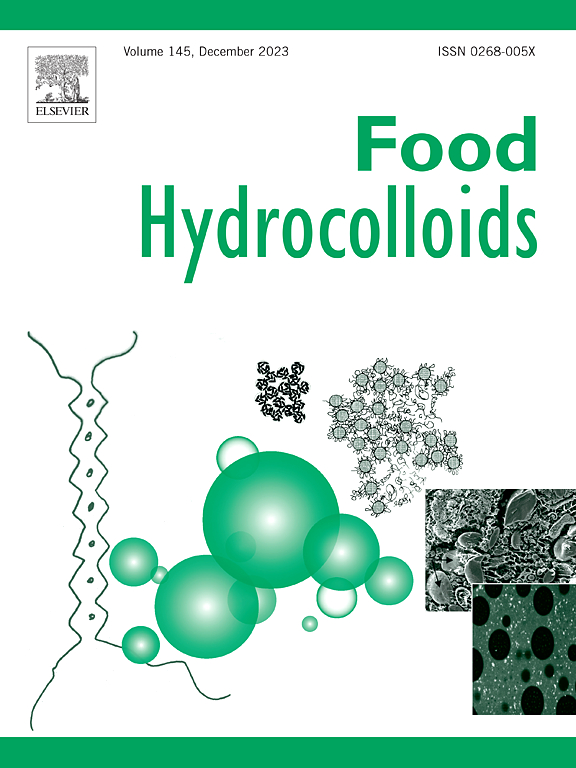Insight of soy protein isolate to decrease the gel properties corn starch based binary system: Rheological and structural investigation
IF 11
1区 农林科学
Q1 CHEMISTRY, APPLIED
引用次数: 0
Abstract
Dysphagia has become a growing concern for elderly individuals, and starch-based gel foods is expected to become one of the foods easy to swallow. This study investigated the effects of soy protein isolate (SPI) on the sol-gel behavior, rheological, structural and gel properties of corn starch (CS). SPI raised the gelatinization temperature but reduced enthalpy values, inhibiting the gelatinization of CS. There was a reduction of rheological properties in CS-SPI system, involving apparent viscosity, modulus, and shear structural recovery properties, while SPI increased the Tan δ, creep-recovery, and thixotropic properties. Structural analysis demonstrated that SPI introduction altered the lamellar structure, increased the relative crystallinity, and decreased the hydrogen bond strength and order degree in CS-SPI gels, forming a weaker gel network. As a result, the texture profiles such as hardness, gumminess, and chewiness were decreased from 308.60 g to 64.98 g, 285.44 g–50.62 g, and 279.66 g–50.15 g, respectively, whereas the gel strength of CS-SPI gel decreased from 123.91 g to 45.78 g. This study provided foundations for the production of gel food suitable for swallowing.

大豆分离蛋白降低玉米淀粉二元体系凝胶特性的启示:流变学和结构研究
吞咽困难已成为老年人日益关注的问题,而基于淀粉的凝胶食品有望成为易于吞咽的食品之一。本研究调查了大豆分离蛋白(SPI)对玉米淀粉(CS)的溶胶-凝胶行为、流变学、结构和凝胶特性的影响。SPI 提高了糊化温度,但降低了焓值,抑制了 CS 的糊化。CS-SPI 体系的流变特性有所降低,包括表观粘度、模量和剪切结构恢复特性,而 SPI 则增加了 Tanδ、蠕变恢复和触变特性。结构分析表明,SPI 的引入改变了 CS-SPI 凝胶的层状结构,增加了相对结晶度,降低了氢键强度和有序度,形成了较弱的凝胶网络。因此,CS-SPI凝胶的硬度、胶粘性和咀嚼性等质地特征分别从308.60克降至64.98克、285.44克至50.62克和279.66克至50.15克,而凝胶强度则从123.91克降至45.78克。
本文章由计算机程序翻译,如有差异,请以英文原文为准。
求助全文
约1分钟内获得全文
求助全文
来源期刊

Food Hydrocolloids
工程技术-食品科技
CiteScore
19.90
自引率
14.00%
发文量
871
审稿时长
37 days
期刊介绍:
Food Hydrocolloids publishes original and innovative research focused on the characterization, functional properties, and applications of hydrocolloid materials used in food products. These hydrocolloids, defined as polysaccharides and proteins of commercial importance, are added to control aspects such as texture, stability, rheology, and sensory properties. The research's primary emphasis should be on the hydrocolloids themselves, with thorough descriptions of their source, nature, and physicochemical characteristics. Manuscripts are expected to clearly outline specific aims and objectives, include a fundamental discussion of research findings at the molecular level, and address the significance of the results. Studies on hydrocolloids in complex formulations should concentrate on their overall properties and mechanisms of action, while simple formulation development studies may not be considered for publication.
The main areas of interest are:
-Chemical and physicochemical characterisation
Thermal properties including glass transitions and conformational changes-
Rheological properties including viscosity, viscoelastic properties and gelation behaviour-
The influence on organoleptic properties-
Interfacial properties including stabilisation of dispersions, emulsions and foams-
Film forming properties with application to edible films and active packaging-
Encapsulation and controlled release of active compounds-
The influence on health including their role as dietary fibre-
Manipulation of hydrocolloid structure and functionality through chemical, biochemical and physical processes-
New hydrocolloids and hydrocolloid sources of commercial potential.
The Journal also publishes Review articles that provide an overview of the latest developments in topics of specific interest to researchers in this field of activity.
 求助内容:
求助内容: 应助结果提醒方式:
应助结果提醒方式:


